Country Indonesia Area 35,377.76 km2 Governor Deddy Mizwar | Capital Population 46.3 million (2014) | |
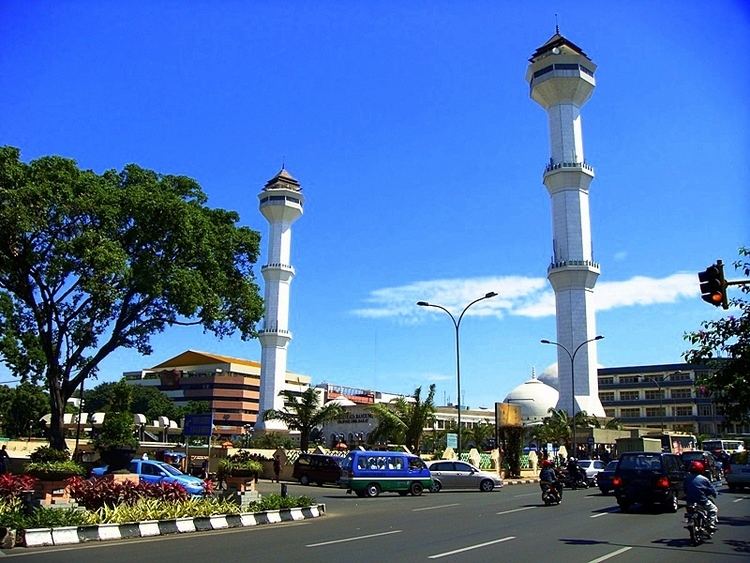 | ||
Colleges and Universities University of Indonesia Destinations Points of interest | ||
Languages spoken | ||
Map of West Java
West Java (Indonesian: Jawa Barat, abbreviated as "Jabar", Sundanese: ᮏᮝ ᮊᮥᮜᮧᮔ᮪) is a province of Indonesia. It is located in the western part of the island of Java and its capital and largest urban center is Bandung, although much of its population in the northwest corner of the province live in areas suburban to the even larger urban area of Jakarta, even though that city itself lies outside the administrative province. The province's population is 46.3 million (in 2014) and it is the most populous and most densely populated of Indonesia's provinces.
Contents
- Map of West Java
- Grand kamala lagoon apartement tertinggi jawa barat di sisi timur jakarta
- Wonderful west java
- History
- Administrative divisions
- Geography
- Economy
- Colonial period
- Post independence
- Tourism
- Demographics
- Etnhnic and linguistic composition
- Culture
- Gamelan orchestra
- Zither ensembles
- Bamboo ensembles
- Puppetry
- Dance
- Folktales and legend stories
- Literature
- Human Development Index
- Toll roads
- Railways
- Education
- References

The central areas of Bogor, a city in West Java, has one of the highest population density worldwide, while Bekasi and Depok are respectively the 7th and 10th most populated suburbs in the world (Tangerang in adjacent Banten province is the 9th); in 2014 Bekasi had 2,510,951 and Depok 1,869,681 inhabitants. All these cities are suburban to Jakarta.
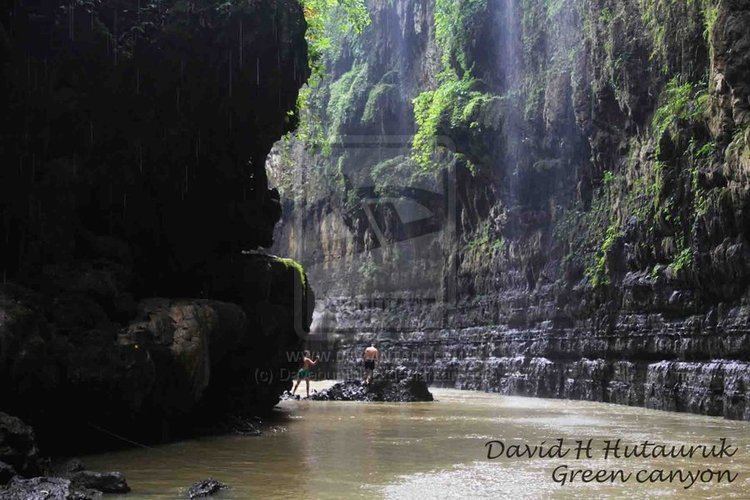
Grand kamala lagoon apartement tertinggi jawa barat di sisi timur jakarta
Wonderful west java
History
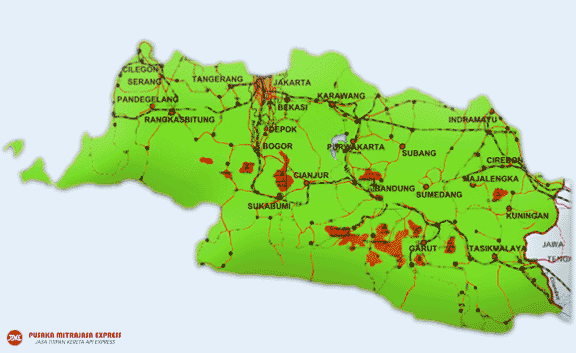
The oldest human inhabitant archaeological findings in the region were unearthed in Anyer (the western coast of Java) with evidence of bronze and iron metallurgical culture dating to the first millennium AD. The prehistoric Buni culture (near present-day Bekasi) clay pottery were later developed with evidence found in Anyer to Cirebon. Artefacts (dated from 400 BC — AD 100), such as food and drink containers, were found mostly as burial gifts. There is also archaeological evidence in Batujaya Archaeological Site dating from the 2nd century and, according to Dr Tony Djubiantono, the head of Bandung Archaeology Agency, Jiwa Temple in Batujaya, Karawang, West Java was also built around this time.
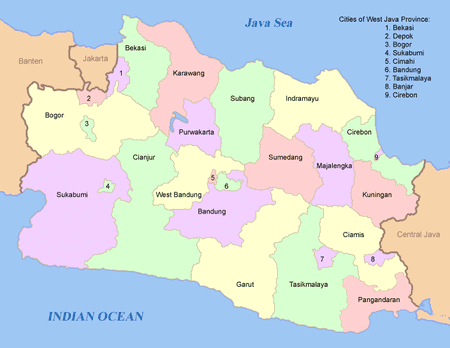
One of the earliest known recorded history in Indonesia is from the former Tarumanagara kingdom, where seven fourth century stones are inscribed in Wengi letters (used in the Indian Pallava period) and in Sanskrit describing the kings of the kingdom Tarumanagara. Records of Tarumanegara's administration lasted until the sixth century, which coincides with the attack of Srivijaya, as stated in the Kota Kapur inscription (AD 686).
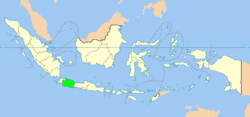
The Sunda Kingdom subsequently became the ruling power of the region, as recorded on the Kebon Kopi II inscription (AD 932).
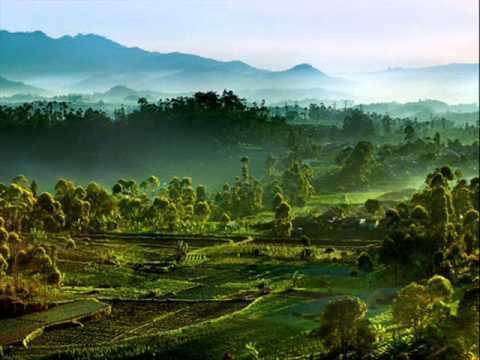
An Ulama, Sunan Gunung Jati, settled in Cirebon, with the intention of spreading the word of Islam in the pagan town. In the meantime, the Sultanate of Demak in central Java grew to an immediate threat against the Sunda kingdom. To defend against the threat, Prabu Surawisesa Jayaperkosa signed a treaty (known as the Luso-Sundanese Treaty) with the Portuguese in 1512. In return, the Portuguese were granted an accession to build fortresses and warehouses in the area, as well as form trading agreements with the kingdom. This first international treaty of West Java with the Europeans was commemorated by the placement of the Padrao stone monument at the bank of the Ciliwung River in 1522.
Although the treaty with the Portuguese had been established, it could not come to realization. Sunda Kalapa harbour fell under the alliance of the Sultanate of Demak and the Sultanate of Cirebon (former vassal state of Sunda kingdom) in 1524, after their troops under Paletehan alias Fadillah Khan had conquered the city. In 1524/1525, their troops under Sunan Gunung Jati also seized the port of Banten and established the Sultanate of Banten which was affiliating with the Sultanate of Demak. The war between the Sunda kingdom with Demak and Cirebon sultanates then continued for five years until a peace treaty were made in 1531 between King Surawisesa and Sunan Gunung Jati. From 1567 to 1579, under the last king Raja Mulya, alias Prabu Surya Kencana, the Sunda kingdom declined, essentially under the pressure from Sultanate of Banten. After 1576, the kingdom could not maintain its capital at Pakuan Pajajaran (the present-day Bogor) and gradually the Sultanate of Banten took over the former Sunda kingdom's region. The Mataram Sultanate from central Java also seized the Priangan region, the southeastern part of the kingdom.
In the sixteenth century, the Dutch and the British trading companies established their trading ships in West Java after the falldown of Sultanate of Banten. For the next three hundred years, West Java fell under the Dutch East Indies' administration. West Java was officially declared as a province of Indonesia in 1950, referring to a statement from Staatblad number 378. On October 17, 2000, as part of nationwide political decentralization, Banten was separated from West Java and made into a new province. There have been recent proposals to rename the province Pasundan ("Land of the Sundanese") after the historical name for West Java.
Administrative divisions
Since the creation of West Bandung Regency in 2008, the Province of West Java has been subdivided into 9 cities (Indonesian: Kota) and 17 regencies (Indonesian: Kabupaten). These 26 cities and regencies are divided into 620 districts (Indonesian: Kecamatan), which comprise 1,576 urban villages (Indonesian: Kelurahan) and 4,301 rural villages (Indonesian: Desa). An 18th regency was formed in October 2012 - Pangandaran Regency - from the southern half of Ciamis Regency; and on 25 October 2013 the Indonesian House of Representatives (DPR) began reviewing draft laws on the establishment of 57 prospective regencies (and 8 new provinces), including a further three regencies in West Java - South Garut (Garut Selatan), North Sukabumi (Sukabumi Utara) and West Bogor (Bogor Barat) - but none of these three new regencies are shown separately on the map below, nor in the following table.
* - the 2005 population is included in the total for Bandung Regency, of which West Bandung Regency was formerly part.
** - the figures for Ciamis Regency include those for the new Pangandaran Regency, created in 2012.
Geography
West Java borders Jakarta and Banten province to the west, and Central Java to the east. To the north is the Java Sea. To the south is the Indian Ocean. Unlike most other provinces in Indonesia which have their capitals in coastal areas, the provincial capital, Bandung, is located in the mountainous area in the centre of the province. Banten Province was formerly part of West Java Province but was created a separate province in 2000. West Java, in the densely populated western third of Java, is home to almost 1 out of every 5 Indonesians.
West Java and Banten provinces, as a part of the Pacific Ring of Fire, have more mountains and volcanoes than any of the other provinces in Indonesia. The vast volcanic mountainous region of inland West Java is traditionally known as Parahyangan (also known as Priangan or Preanger) which means "The abode of hyangs (gods)". It is considered as the heartland of the Sundanese people. The highest point of West Java is the stratovolcano Mount Cereme (3,078 meters) bordering Kuningan and Majalengka Regencies. West Java has rich and fertile volcanic soil. Agriculture, especially traditional dry rice cultivation (known as ladang or huma), has become the main way of life of traditional Sundanese people. Since the colonial VOC and Dutch East Indies era, West Java has been known as a productive plantation area for coffee, tea, quinine, and many other cash crops. The mountainous region of West Java is also a major producer of vegetables and decorative flowering plants. Sunny tropical sites with a cool atmosphere and beautiful scenery are frequently across almost all of West Java and Banten except in the northern parts ( the Java sea beaches). The landscape of the province is one of volcanic mountains, steep terrain, forest, mountains, rivers, fertile agricultural land, and natural sea harbours.
Flowing through Bandung Basin to the northeast is Citarum River, the longest and most important river in the province. This 300-km long river is the site of 3 dams, namely Cirata Dam, Saguling Dam, and Jatiluhur Dam. The river is heavily polluted by industrial and household sewage to the point that it has been called as 'the world's dirtiest river' by some.
Economy
Initially, the economy of the Sundanese people in West Java relied heavily on rice cultivation. Ancient kingdoms established in West Java such as the Tarumanagara and Sunda Kingdom are known to have relied on rice taxes and agriculture revenues. The cycle of life of the ancient Sundanese people revolved around the rice crop cycle. Traditional rice harvest festivals such as the Seren Taun were important. The ancient goddess of rice, Nyai Pohaci Sanghyang Asri, is revered in Sundanese culture. Traditionally, Sundanese people often used dry rice cultivation (ladang). After the Mataram expanded to the Priangan area in the early 17th century following the Sultan Agung campaign against Dutch Batavia, sawah (wet rice cultivation) began to be adopted in the northern lowlands of West Java. Regencies such as Indramayu, Cirebon, Subang, Karawang and Bekasi are now well known as key rice producing areas. The mountainous region of West Java supplies vegetables, flower and many horticultural produce to Jakarta and Bandung. Animal farms in West Java produce dairy products and meats.
Colonial period
During the Dutch East India Company (VOC) and Dutch East Indies era, West Java fell under Dutch administration centered in Batavia. The Dutch colonial government introduced cash crops such as tea, coffee, and quinine. Since the 18th century, West Java (known as "De Preanger") was known as a productive plantation area, and became integrated with global trade and economy. Services such as transportation and banking were provided to cater for wealthy Dutch plantation owners. West Java is known as one of the earliest developed regions in the Indonesian archipelago. In the early 20th century, the Dutch colonial government developed infrastructures for economic purposes, especially to support Dutch plantations in the region. Roads and railways were constructed to connect inland plantations area with urban centers such as Bandung and port of Batavia.
Post independence
After Indonesian independence in 1945, West Java became a supporting region for Jakarta, the Indonesian capital. Jakarta remained as the business and political center of Indonesia. Several regencies and cities in West Java such as Bogor, Bekasi and Depok were developed as supporting areas for Jakarta and came to form the Greater Jakarta area or Jabodetabek (Jakarta, Bogor, Depok and Bekasi). The northern area of West Java has become a major industrial area. Areas such as Bekasi, Cikarang and Karawang are sprawling with factories and industries. The area in and around Bandung also developed as industrial area.
Tourism
Endowed with natural beauty and rich culture, tourism is also an important industry in West Java. The Puncak area and Bandung have long been known as popular weekend destinations for Jakartans. Today Bandung has developed into a chic and fashionable shopping destination, popular not only among local Indonesian especially Jakartans, but also a popular shopping destination for neighboring Malaysian and Singaporeans. The ancient coastal city of Cirebon is also popular as cultural tourism destination since the city has several kratons and many historical sites such as Gua Sunyaragi. Other popular tourism destinations include the Bogor Botanical Garden, Taman Safari Indonesia, Tangkuban Perahu crater, Ciater hot springs, Kawah Putih crater to the south of Bandung, Pangandaran beach, and various mountain resorts in Cianjur, Garut, Tasikmalaya, and Kuningan.
Demographics
The population of West Java was put at 43,054,000 in mid-2010 making it the most populous province of Indonesia, home to 18% of the national total on 1.8% of the national land. Aside from the special district of Jakarta, it is the most densely populated province in the country with an average of 1,236 people per km² (2010 data). The population growth rate recorded in the ten years to 2010 was 1.9%,
Etnhnic and linguistic composition
West Java is the native homeland of Sundanese people which forms the largest ethnic group in West Java, followed by Javanese who migrated to the province centuries ago. Since Jakarta and the surrounding area, including West Java, is the business and political center of Indonesia, the province has attracted various people from throughout Indonesia. Other Native Indonesian ethnic groups such as Minangkabau, Batak, Malay, Madurese, Balinese, Ambonese and many other Indonesians who migrated to and settled in West Java cities can also be easily found. West Java urban areas also have a significant population of Chinese Indonesians.
In addition to Indonesian, the official national language, the other widely spoken language in the province is Sundanese. In some areas near the southern borders with Central Java, Javanese is also spoken. The main language spoken in Cirebon and nearby areas (Majalengka, Indramayu, Sumber) is Cirebonese, a dialect of Javanese with Sundanese influence.
Indonesian is widely spoken as a second language.
Culture
The Sundanese share Java island with the Javanese people and primarily live in West Java. Although the Sundanese live in the same island as the Javanese, their culture is distinct and they likewise consider themselves to live in a separate cultural area called Pasundan or Tatar Sunda. Someone moving from West Java Province to Central or East Java Provinces is literally said to be moving from Sunda to Java worlds. Bandung, the capital city of West Java, is considered as the cultural heartland of Sundanese people. Many indigenous Sundanese artforms were developed in this city. The nearby province of Banten, which was formerly part of West Java before it became its own province, is similar in this regard and is also considered to be part of Pasundan as well.
Gamelan orchestra
The musical arts of Sunda, which is an expression of the emotions of Sundanese culture, express politeness and grace of Sundanese. Degung orchestra consists of Sundanese gamelan.
In addition to the Sundanese forms of Gamelan in Parahyangan, the region of Cirebon retains its own distinct musical traditions. Amongst Cirebons' varying Gamelan ensembles the two most frequently heard are Gamelan Pelog (a non-equidistant heptatonic tuning system) and Gamelan Prawa (a semi-equidistant pentatonic tuning system). Gamelan Pelog is traditionally reserved for Tayuban, Wayang Cepak, and for listening and dance music of the Kratons in Cirebon. Whereas Gamelan Prawa is traditionally reserved for Wayang Purwa.
Cirebon also retains specialized Gamelan ensembles including: Sekaten, which is played in the Kratons to mark important times in the Islamic calendar. Denggung, also a Kraton ensemble which is believed to have a number of "supernatural powers". And Renteng, an ensemble found in both Cirebon and Parahyangan that is known for its loud and energetic playing style.
Zither ensembles
Tembang Sunda is a genre of Sundanese vocal music accompanied by a core ensemble of two kacapi (zither) and a suling (bamboo flute). Tembang means song or poem and Sunda is a geographical, historical, and cultural construct which signifies home for the Sundanese people of Indonesia. The music and poetry of tembang Sunda are closely associated with the Parahyangan (literally the abode of the gods), the highland plateau that transverses the central and southern parts of Sunda. The natural beauty of Priangan, a lush agricultural region surrounded by mountains and volcanoes, politeness and grace of Sundanese is reflected in many songs of the tembang Sunda.
Kacapi suling is tembang Sunda minus vocal.
Tarawangsa is a genuine popular art is performed on ensemble consists of tarawangsa (a violin with an end pin) and the jentreng (a kind of seven-stringed zither). It is accompanied by a secret dance called Jentreng. The dance is a part of a ritual celebrating the goddess of paddy Dewi Sri. Its ceremonial significance is associated with a ritual of thanksgiving associated with the rice harvest. Tarawangsa can also be played for healing or even purely for entertainment.
Bamboo ensembles
The three main types of Sundanese bamboo ensembles are angklung, calung, and arumba. The exact features of each ensemble vary according to context, related instruments, and relative popularity.
Angklung is a generic term for sets of tuned, shaken bamboo rattles. Angklung consists of a frame upon which hang several different lengths of hollow bamboo. Angklungs are played like handbells, with each instrument played to a different note. Angklung rattles are played in interlocking patterns, usually with only one or two instruments played per person. The ensemble is used in Sundanese processions, sometimes with trance or acrobatics. Performed at life-cycle rituals and feasts (hajat), angklung is believed to maintain balance and harmony in the village. In its most modern incarnation, angklung is performed in schools as an aid to learning about music.
The Angklung got more international attention when Daeng Soetigna, from Bandung, West Java, expanded the angklung notations not only to play traditional pélog or sléndro scales, but also diatonic scale in 1938. Since then, angklung is often played together with other western music instruments in an orchestra. One of the first well-known performances of angklung in an orchestra was during the Bandung Conference in 1955.
Like those in angklung, the instruments of the calung ensemble are of bamboo, but each consists of several differently tuned tubes fixed onto a piece of bamboo; the player holds the instrument in his left hand and strikes it with a beater held in his right. The highest-pitched calung has the greatest number of tubes and the densest musical activity; the lowest-pitched, with two tubes, has the least. Calung is nearly always associated with earthy humor, and is played by men.
Arumba refers to a set of diatonically tuned bamboo xylophones, often played by women. It is frequently joined by modern instruments, including a drum set, electric guitar, bass, and keyboards.
Puppetry
Wayang golek is a traditional form of puppetry from Sunda. Unlike the better-known leather shadow puppets (wayang kulit) found in the rest of Java and Bali, wayang golek puppets are made from wood and are three-dimensional, rather than two. They use a banana palm in which the puppets stand, behind which one puppeteer (dalang) is accompanied by his gamelan orchestra with up to 20 musicians. The gamelan uses a five-note scale as opposed to the seven-note western scale. The musicians are guided by the drummer, who in turn is guided by signals from the puppet master dalang gives to change the mood or pace required. Wayang golek are used by the Sundanese to tell the epic play "Mahabarata" and various other morality type plays.
Dance
Sundanese dance shows the influence of the many groups that have traded and settled in the area over the centuries, but remains uniquely distinctive, with its variation from graceful to dynamic syncopated drumming patterns, quick wrist flicks, sensual hip movements, and fast shoulder and torso isolations. Jaipongan is probably the most popular traditional social dance of Sundanese people. It can be performed in solo, in group, or in pair. The Tari Merak (Peafowl Dance) is a female dance inspired by the movements of a peafowl and its feathers blended with the classical movements of Sundanese dance. The Tari Merak symbolises the beauty of nature.
Folktales and legend stories
There are stories and folktales transcribed from Pantun Sunda stories. Among the most well known folktale and stories are:
Literature
Old Sundanese literature, among others, are:
Human Development Index
Cities and Regencies in West Java range high to medium Human Development Index (HDI).
Toll roads
Due to its proximity to the capital city and its growing population and industry, West Java has the longest tolled highway road of any provinces. As of April 2015, there are several toll roads in West Java
In addition to completed highways there are some highways that are being built, one of them is Cileunyi–Sumedang–Dawuan (Cisumdawu) with length 60.1 kilometres.
Several other proposed toll roads are Soreang–Pasirkoja, Bandung Intra-Urban Toll Road, Ciawi–Sukabumi, Cileunyi–Tasikmalaya, and Jakarta Outer Ring Road 2 (a section of this road has been built).
Railways
Most cities and towns in West Java are served with narrow-gauge (mainly 1067mm) lines and connected to other provinces on Java Island.
A high-speed railway is now under construction, connecting Jakarta and Bandung.
Education
West Java is one of the most popular destinations for higher education in Indonesia. It has many well-known universities joined by many students from the entire country. Some of which are:
